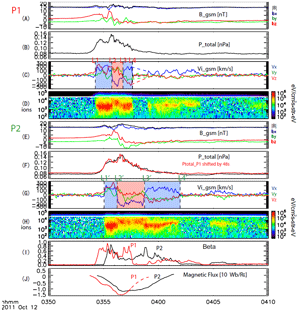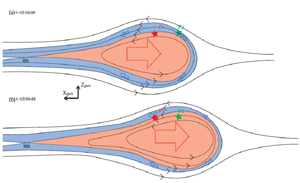2013 ARTEMIS SCIENCE NUGGETS
Plasmoid growth and expulsion revealed by two-point ARTEMIS observations
by Shanshan Li, UCLA ESS & IGPP
Introduction
As predicted by the near-Earth-neutral-line (NENL) substorm model, a plasmoid is formed between the NENL and distant-neutral-line (DNL). After NENL reconnections proceed to the lobe field lines, the plasmoid will be ejected tailward (or Earthward). Statistical studies show that plasmoids have significantly smaller sizes (in XGSM) at the near-Earth tail compared to their sizes at the distant-tail. No direct observation has ever shown their expected growth, and no theory can yet explain how small plasmoids evolve to larger sizes.
Observations
On Oct. 12th 2011, ARTEMIS-P1 and P2 were located at XGSM ~-60 RE, at about 9 RE above the neutral sheet (originally in the northern lobe) and with a 4 RE separation mainly in XGSM. A plasmoid with bipolar Bz signature (Panel A, E) and total pressure enhancement (Panel B, F) was observed by P1 and P2 sequentially, indicating its fast tailward propagation speed of over 500km/s. Both of the two ARTEMIS probes traversed the plasmoid near its northern boundary and they observed similar earthward-tailward-earthward flow (Panel C,G) during their traversals inside the plasma sheet, which suggest the plasmoid having a multi-layer structure – a tailward plasmoid proper wrapped in the plasma sheet with earthward flow. Meanwhile, this plasmoid proper (marked by light red shadow in Panel C, G and also clearly seen in the energy spectrogram-Panel D,H) gains sizes in XZ plane and results in the significantly longer observation duration by P2. Moreover, the electrons show cigar-type or near-isotropic distributions in the region where we observed the earthward flow, which indicating these particles were accelerated from close to the central plasma sheet, not from an active DNL reconnection site.
| Figure 1. Summary Plot including B, total P, V, energy spectrogram, Beta and magnetic flux. |
| Figure 2. Cartoon illustration of plasmoid growth and location of spacecraft observations. |
Conclusion
We interpret the observations and diagram illustrated in Figure 2. The observed, fast-propagating plasmoid proper (marked by light red shadow in Figure 2) is formed and ejected by plasma sheet field line reconnections only. In this case, lobe field line reconnections are not necessary for plasmoid ejections. The compression due to the approaching plasmoid proper and the plasma sheet tension force accelerates the ambient plasma sheet plasma (marked by light blue shadow) earthward. Since the plasma sheet reconnection continues after the ejection of this plasmoid proper, it grows rapidly as observed. This explains the big difference of plasmoid sizes between the near-Earth tail and the distant-tail.
Reference
S.-S. Li, V. Angelopoulos, A. Runov, S.A. Kiehas1, X.-Z. Zhou (2013), Plasmoid growth and expulsion revealed by two-point ARTEMIS observations, J. Geophys. Res., in press.Biographical Note
Shanshan Li is a graduate student in the Experimental Space Physics Group at UCLA, under Professor Vassilis Angelopoulos. Her research interests focus on phenomena in the Earth’s magnetosphere, especially in the magnetotail. She analyzes data collected by the THEMIS/ARTEMIS spacecraft and performs both case study and statistical analyses. By studying the the dipolarization fronts (DFs) and the plasmoids with multi-point observations, her work aims to test and refine the substorm model in three-dimensional space.
 Please send comments/suggestions to
Emmanuel Masongsong / emasongsong@igpp.ucla.edu
Please send comments/suggestions to
Emmanuel Masongsong / emasongsong@igpp.ucla.edu

